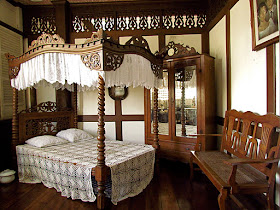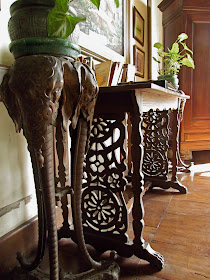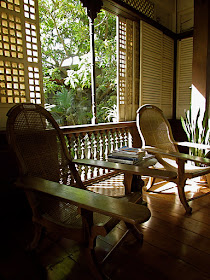Lipa is one of the few Philippine cities (and towns) whose main street is not called Rizal. Instead, it is named after Claro Recto, a nationalist and one of the city's most distinguished sons. The other major thoroughfares pay tribute to equally-prominent Lipéňos: Morada, Luz, Kalaw.
The house is a fine example of colonial tropical architecture; it dates from 1880 and is in excellent shape to this day, one of the city's five remaining Spanish-era houses that survived World War II, earthquakes, and typhoons. In fact, this particular ancestral house has this wonderful, lived-in ambience: Segunda's descendants live within the compound and personally attend to every guest who knocks in their gate.
The nárra floors are polished, the capíz windows are complete, the planters and pedestals are filled with greens, and the compound seems to be always abuzz with activity. Once I was there, the barangáy was having a meeting in the courtyard.
Despite the heat and the sunshine outside, it was pleasantly cool and breezy within the rooms, the corridors, and especially in the foyer downstairs. Of course, the compound is sheltered by old trees that further enhances the shady and balmy atmosphere.
Casa de Segunda requests a token amount of twenty pesos to help maintain their house. They are open everyday but big groups best book ahead.









Lovely photos.. done with good taste. I love the details on the elephant stand beside the console.
ReplyDeleteBeautiful home, and historical too! It does give a cool, airy feel... Could you possibly build something like this in 1784? Of course it will be more modern, but tropical still. Just dreaming.... :-)
ReplyDeleteThanks for posting this, as I have long wanted to visit this but somehow farther places had the priority. It is always like that with me, nearby areas are relegated to the future, which sometimes does not come. I am also interested with the alagao tree, how big is its trunk now? I am amazed i still remember its Scientific name, Premna odorata, as an alagao tree at the sidewalk of the university is labeled like that!
ReplyDelete@Jonathan: Thanks! Precisely, the elephant pedestal caught my eye too.
ReplyDelete@Big Sis: Hmmmm, why not? But I'm not sure how organic it would look with the surroundings, especially on the cliffside. We'll see...
@Andrea: Yeah, that's how it is with everyone, including myself. the alagao tree's height and girth is just like an old narra.
We tried to visit Casa Segunda before but we were not allowed to enter the house, this was three years ago. I think it's time to visit Lipa again for a cultural tour. Lovely pics! (as usual)
ReplyDeleteYeah, come over anytime! I'll be featuring some more interesting spots in the next weeks :)
ReplyDeleteStill open to public?
ReplyDeleteyes :)
DeleteThank you for the pictures. I am from Sri Lanka
DeleteRustic, romantic, nostalgic, beautiful. I did imagine living there, and I only saw the pictures here. I heard a guitar playing kundiman, as a lovely maiden with long simple hair hummed from her hammock. When life was simple....when the air was scented of freshly-cut grass and the season's fruits. the voices of children playing "taguan" .....thank you for the share
ReplyDelete